How shall we look at Salt Creek?
First of all, who cares? Isn’t this just another little stream which turns into a commercial/industrial creek, leading to a nondescript harbor? It’s not that there’s anything wrong with it; it’s just not particularly special. There are hundreds of creeks just like it all over Florida. Only the most rabid ecologist could make a case that it is specially deserving of protection.
Or is that really true? I paddled up the creek not long ago with low expectations, only to discover that it holds a few special treats for a careful observer. First of all, the creek is home to many of the birds, large and small, which make Florida really special. No one can ever forget the sight of a great blue heron landing in a longleaf pine, as we saw on this trip.
That graceful feathered dinosaur came flapping in at considerable speed, pulled up at the last minute to a perfect stall, grabbed a branch in his talons, and let out a querulous squawk to announce his arrival. Never mind that the pine tree was between a marina and a warehouse; the memory is brilliant.
Or, how about the fat pelican perched on the roof of a warehouse? That big, goofy clown of the airways looked down at us splashing our way up the creek – he must have had a laugh as we snatched plastic bottles and other trash out of the mangroves. Why bother with that on Salt Creek?
Nature can be less than Garrard’s Wilderness or even Pastoral. Of course, it’s wonderful to walk in the forest primeval with the leaves crunching underfoot, the smell of pine needles in your nose, and the sound of a mockingbird in your ears, looking over the ridge for the sight of a panther. But that’s not next door for all of us. We can’t all jump in our kayaks and paddle out on the flats of the Crystal River as it flows into the Gulf, with the baby nurse sharks lying sluggishly on the bottom and the rays flapping lazily along the riverbed.
But if Laura can walk to work over Thrill Hill and look down into Salt Creek to see a pelican working over the baitfish, that’s not a bad nature fix. An osprey diving for his lunch is still a thrill whether you see it in the Everglades or from the dock at your local marina.
That’s what makes Salt Creek worth saving. We shouldn’t aspire to take it back to the Tocobago times. Let’s just keep it clean, so it can support the plants, the fish and the birds which make it so much fun for us all. Even Thoreau in his Walden cabin wasn’t waiting for Squanto to show up with a handful of corn and the drumstick of a turkey he had just shot with his bow and arrow. He planted his beans and made other improvements to accommodate Nature to his needs and desires. Let’s take a leaf from his book and just improve the little corner where we are. That’s how I look at Salt Creek.
Too many ecologists and nature writers get so wrapped up in their romantic vision of Nature (with a capital N) that they lose sight of what’s practical, and lose their followers at the same time. The perfect is the enemy of pretty-damned-good.
Instead, they should learn to spell nature with a lower case n, accept the fact that it’s never going to be as pristine as they might like, and make the best of it. Introduce the changes (hopefully improvements) which a majority of people can live with, avoid the really stupid stuff like straightening the Kissimee River or draining the
Everglades, do your best to keep the corporate developers at bay, and build a consensus. By now, most of the general public is tired of hearing about the snail darter and the spotted owl; they want to find a compromise which will avoid mass extinctions and still let the loggers earn a living.
Consensus is not going to be possible on all the issues, so they’ll have to select a few issues very carefully and cleverly, nail their colors to the mast and fight the good fight but do that in a spirit of comity and not burn every bridge in the county. Jenny Price seems to have a good message for us in her “Urban Denizen”. I would summarize her theme as “Nature is where you are – make the best of it.”
Her five questions can help us to look at nature with a purpose. Her first question – “What and where are the wild things?” is probably too global, but let’s zero in on a local application and say, “Salt Creek is marinas and warehouses, bridges and dams, garbage and pollution, but it is equally birds and fish, mangroves and palmettos, blue sky and flowing water.”
It’s too facile to focus too much on either side of this equation. Both sides have their value or at least raison d’être. The marinas and warehouses add value to the creek at the same time they lead to the pollution and garbage. You can’t live in a house without tracking in mud occasionally and eventually wearing out the carpet.
That leads us to her question two, “How do people use nature as resources?” Salt Creek’s marinas and warehouses are money-makers, and that means that they help pay the taxes which support our ecological efforts. We can welcome commercial and industrial activity along the creek, while protecting it with appropriate regulations to limit dangerous effluents and other damage. That doesn’t mean that the oil tank farms of the ‘20’s and 30’s were blameless – I’d bet that they leaked all sorts of nasty stuff into the creek now and then. However, we’ve learned a few lessons since then, and can learn to stop that, too.
That allows us to get in our kayaks and paddle up the stream to see what we can find. And what do we find? Healthy mangrove thickets are providing a habitat for all sorts of fish and other marine life, even among the plastic cups and bottles. There doesn’t appear to be much liquid pollution, although an occasional glimpse of petroleum’s rainbow sheen on the water tells us that we’re not in a pristine environment. The herons, egrets and even ospreys soar overhead, along with the ubiquitous seagulls, confirming that there is food on the menu here in the creek. And it’s all there for us to see if we’ll just get out and look. This confirms to me that we’ve probably reached a sustainable balance; one which could be improved, certainly, but nonetheless sustainable.
Price’s third question asks how we transform the landscape we live in and how does nature act back? In addition to all the examples above, perhaps the single most striking example for Salt Creek is the dam which turned Lake Maggiore into a freshwater lake in the 1930s. The first thing which happened was massive fish kills on both sides of the dam. The salt water fish in the lake turned belly up, and the freshwater fish trapped downstream gasped and died. Sea grass in the lake died and smothered marine life all around. Later, when public works opened the dam to release excess fresh water in the lake, they killed mullet in the creek “… by the ton”.
“How do different people encounter nature differently?” asks Price in question 4. There are so many examples. Kayakers have a typical nature experience, but people having a beer along the rail at Fish Tales can also watch the birds. The boaters may take a minute to look around as they putt-putt into their berths, and even the warehouse man may glance around while he smokes a cigarette on his break. Who’s to say that any of these experiences is more valid than the others? Which of these people is more virtuously attuned with nature? An objective answer might surprise us.
Finally, Price wants to know how people imagine and understand nature. This can cover the entire gamut, from enchantment at the flight of the egret to Totch Brown’s appreciation for egrets served as Chokoloskee chicken. No matter how we may romanticize it, nature is still out there, red in tooth and claw. Given a chance, the alligator will still eat your poodle, and the osprey will snatch the mullet out of the water for lunch. And if the osprey has his perch on the top of your condo, your balcony will be covered with blood and fish guts.
If you can’t find nature in the city, you must be willfully blind. Get out and enjoy it!
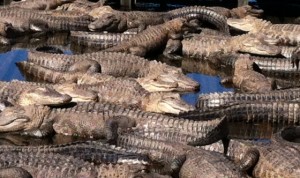


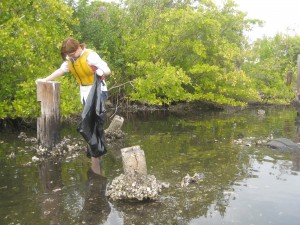 Simply said life creates boundaries that are out of human control. Unfortunate events happen, and there is nothing we can do about it. I came to the conclusion after seeing a bumper sticker that “Life Happens”; it struck me on a personal level. More specifically I am a control freak. If something is not controllable then it’s just not a possibility in my life. As small, yucky and insignificant as Salt Creek is, it can teach a valuable life lesson on boundaries to anyone who explores its waters.
Simply said life creates boundaries that are out of human control. Unfortunate events happen, and there is nothing we can do about it. I came to the conclusion after seeing a bumper sticker that “Life Happens”; it struck me on a personal level. More specifically I am a control freak. If something is not controllable then it’s just not a possibility in my life. As small, yucky and insignificant as Salt Creek is, it can teach a valuable life lesson on boundaries to anyone who explores its waters.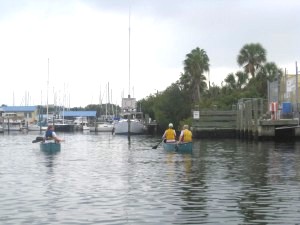 I walk into the shady hideout, and the smell of sulfur, burning hydrocarbons, beer, and fish stain my nose. Combined, these odors equal a recipe for home. The poor craftsmanship of the bar just emphasizes that backyard feeling, while the view from the barstool frames it. Fish Tale’s is surrounded by boats in mooring, a marina to port, and adolescent like growth patch of mangroves forward. Year-round Christmas lights highlight the garage sale assortment of décor inside.
I walk into the shady hideout, and the smell of sulfur, burning hydrocarbons, beer, and fish stain my nose. Combined, these odors equal a recipe for home. The poor craftsmanship of the bar just emphasizes that backyard feeling, while the view from the barstool frames it. Fish Tale’s is surrounded by boats in mooring, a marina to port, and adolescent like growth patch of mangroves forward. Year-round Christmas lights highlight the garage sale assortment of décor inside.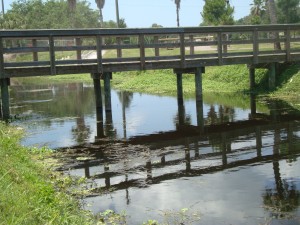
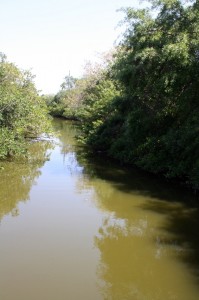
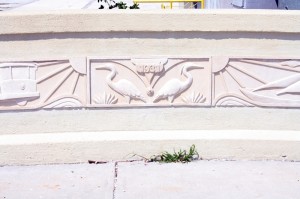 Ready?
Ready?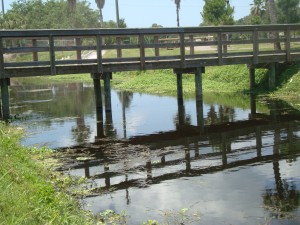 Remember when you were young and school had “party” days, “rec” days, or all day field trips? Those were the best days of the school year. Party days had pizza, juice and usually some educational or Disney movie playing. Rec days were like having all day recess and sometimes the adults played too. The all-day field trip was everyone’s favorite. Once you got to school a bus took the class to its destination and you didn’t have to see the classroom until it was time to grab your belongings and go back home. At the college level, the “best school day ever” is a little more structured and refined but the point is that it still exists. For me, it happened on a Thursday on a lake in a park with about ten of my peers, a professor and his friend.
Remember when you were young and school had “party” days, “rec” days, or all day field trips? Those were the best days of the school year. Party days had pizza, juice and usually some educational or Disney movie playing. Rec days were like having all day recess and sometimes the adults played too. The all-day field trip was everyone’s favorite. Once you got to school a bus took the class to its destination and you didn’t have to see the classroom until it was time to grab your belongings and go back home. At the college level, the “best school day ever” is a little more structured and refined but the point is that it still exists. For me, it happened on a Thursday on a lake in a park with about ten of my peers, a professor and his friend.